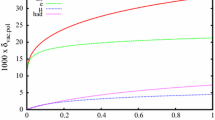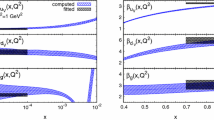Abstract
The structure function approach and the parton picture, developed for the theoretical description of the deep inelastic electron-proton scattering, also proved to be very effective for calculation of radiative corrections in Quantum Electrodynamics. We use them to calculate radiative corrections to the cross section of electron-proton scattering due to electron-photon interaction, in the experimental setup with the recoil proton detection, proposed by A. A. Vorobyev to measure the proton radius. In the one-loop approximation, explicit expressions for these corrections are obtained for arbitrary momentum transfers. It is shown that, at momentum transfers small compared with the proton mass, various contributions to the corrections mutually cancel each other with power accuracy. In two loops, the corrections are obtained in the leading logarithmic approximation.

Similar content being viewed by others
Data Availability Statement
This manuscript has no associated data or the data will not be deposited. [Authors’ comment: This is a theoretical study and no experimental datasets were generated or analysed.]
Notes
Higher order corrections to the lepton line was considered for the standard experimental set-up with scattered electron measurement in [19].
References
A. Beyer et al., Science 358(6359), 79 (2017)
N. Bezginov et al., Science 365(6457), 1007 (2019)
W. Xiong et al., Nature 575(7781), 147 (2019)
R. Pohl et al., Nature 466, 213 (2010)
A. Antognini et al., Science 339, 417 (2013)
P. J. Mohr, B. N. Taylor and D. B. Newell, Rev. Mod. Phys. 80 (2008) 633. arXiv:0801.0028 [physics.atom-ph]
R. Pohl, R. Gilman, G. A. Miller and K. Pachucki, Ann. Rev. Nucl. Part. Sci. 63 (2013) 175. arXiv:1301.0905 [physics.atom-ph]
J. C. Bernauer, in 34th International Symposium on Physics in Collision (PIC 2014), Sep 16-20 2014, Bloomington, Indiana, USA. arXiv:1411.3743 [nucl-ex]
C.E. Carlson, Prog. Part. Nucl. Phys. 82, 59 (2015). arXiv:1502.05314 [hep-ph]
J.P. Karr, D. Marchand, E. Voutier, Nat. Rev. Phys. 2(11), 601–614 (2020)
J. C. Bernauer et al. [A1 Collaboration], Phys. Rev. Lett. 105 (2010) 242001. arXiv:1007.5076 [nucl-ex]
X. Zhan et al., Phys. Lett. B 705, 59 (2011). arXiv:1102.0318 [nucl-ex]
H. Fleurbaey et al., Phys. Rev. Lett. 120 (2018) no.18, 183001. arXiv:1801.08816 [physics.atom-ph]]
A. Vorobyev, Phys. Part. Nucl. Lett. 16 (2019) no.5, 524. arXiv:1905.03181 [nucl-ex]
Y.-S. Tsai, Phys. Rev. 122, 1898 (1961)
N. Meister, D.R. Yennie, Phys. Rev. 130, 1210 (1963)
L.W. Mo, Y.-S. Tsai, Rev. Mod. Phys. 41, 205 (1969)
L.C. Maximon, J.A. Tjon, Phys. Rev. C 62, 054320 (2000). arXiv: nucl-th/0002058
A.B. Arbuzov, T.V. Kopylova, Eur. Phys. J. C 75, 603 (2015). arXiv:1510.06497 [hep-ph]
C.E. Carlson, M. Vanderhaeghen, Ann. Rev. Nucl. Part. Sci. 57, 171 (2007). arXiv: hep-ph/0701272
J. Arrington, P. G. Blunden and W. Melnitchouk, Prog. Part. Nucl. Phys. 66 (2011) 782. arXiv:1105.0951 [nucl-th]
A. Afanasev, P.G. Blunden, D. Hasell, B.A. Raue, Prog. Part. Nucl. Phys. 95, 245 (2017). arXiv:1703.03874 [nucl-ex]
I.A. Qattan et al., Phys. Rev. Lett. 94, 142301 (2005). arXiv: nucl-ex/0410010
V.S. Fadin, R.E. Gerasimov, Phys. Lett. B 795, 172 (2019)
A.A. Akhundov, D.Y. Bardin, L. Kalinovskaya, T. Riemann, Fortsch. Phys. 44, 373 (1996). arXiv: hep-ph/9407266
A. Arbuzov, D.Y. Bardin, J. Blumlein, L. Kalinovskaya, T. Riemann, Comput. Phys. Commun. 94, 128 (1996). arXiv: hep-ph/9511434
V. N. Gribov and L. N. Lipatov, Sov. J. Nucl. Phys. 15 (1972) 438; [Yad. Fiz. 15 (1972) 781]
V. N. Gribov and L. N. Lipatov, Sov. J. Nucl. Phys. 15 (1972) 675; [Yad. Fiz. 15 (1972) 1218]
L. N. Lipatov, Sov. J. Nucl. Phys. 20 (1975) 94; [Yad. Fiz. 20 (1974) 181]
G. Altarelli, G. Parisi, Nucl. Phys. B 126, 298 (1977)
Y. L. Dokshitzer, Sov. Phys. JETP 46 (1977) 641; [Zh. Eksp. Teor. Fiz. 73 (1977) 1216]
E. Kuraev and V. S. Fadin, Sov. J. Nucl. Phys. 41 (1985) 466; [Yad. Fiz. 41 (1985) 733]; DESY L-Trans-297
V. P. Berestetsky, E. M. Lifshits, L. P. Pitaevsky, Quantum electrodynamics (Science. Ch. ed. Phys.-Mat. Lit., Moscow, 1989) 728 p
V.N. Baier, V.M. Katkov, V.S. Fadin, Radiation of relativistic electrons (Atomizdat, Moscow, 1973), p. 374
C.G. Callan Jr., D.J. Gross, Phys. Rev. Lett. 22, 156 (1969)
J. Blumlein and H. Kawamura, Eur. Phys. J. C 51 (2007), 317. arXiv:hep-ph/0701019 [hep-ph]
V. Bertone, M. Cacciari, S. Frixione, G. Stagnitto, JHEP 03, 135 (2020)
T. Liu, W. Melnitchouk, J. W. Qiu and N. Sato. arXiv:2008.02895 [hep-ph]
E. De Rafael, J.L. Rosner, Ann. Phys. 82, 369 (1974)
T. Aoyama, and others, Phys. Rept. 887 (2020) 1. arXiv:2006.04822 [hep-ph]
Acknowledgements
Work supported in part by the Ministry of Science and Higher Education of Russian Federation and in part by RFBR, Grant 19-02-00690.
Author information
Authors and Affiliations
Corresponding author
Additional information
Communicated by Reinhard Alkofer.
Appendices
Appendix A
The vacuum polarisation \(\mathcal{P}(q^2)\) contains lepton (electron, muon, \(\tau \)-lepton ) and hadron contributions:
One-loop lepton contribution \(\mathcal {P}^{(1)}_{l}(q^2), \;\;( l=e, \mu , \tau )\) is well known (see, for example, [33]):
At \(Q^2 =-q^2 \gg 4m_l^2\)
and at \(Q^2 =-q^2 \ll 4m_l^2\)
The lepton contributions are known also in higher orders of perturbation theory (see, for example, [39, 40]). For us it is enough to know that the two-loop contribution contains only the first degree of \(\ln \left( \frac{Q^2}{m_l^2}\right) \).
The hadron contribution \(\mathcal{P}_h(q^2)\) is expressed in terms of the total cross section of one-photon electron-positron pair annihilation into hadrons
This contribution is small compared with \(\alpha /\pi \) at \(Q^2 < 4m^2_{\pi }\), becomes of order of \(\alpha /\pi \) only at \(Q^2\sim 4m^2_{\pi }\) and then grows logarithmically with \(Q^2\). Recent review is given in [40].
Appendix B
To find the contribution \(\delta ^e_{hard}\) of the one-photon emission with \(\kappa '>\kappa _0\) to the radiative correction \(\delta ^e\) at \(Q^2\gg m^2\) it is convenient to introduce the intermediate scale \(\kappa _1\) such that \(Q^2\gg \kappa _1\gg m^2\). In the region \(\kappa _1>\kappa '>\kappa _0\) one can put
so that
Therefore in this region we have from Eqs. (22)–(24)
Using that in this region it is possible to put \(\kappa ' = Q^2(1-x)/2\), it is easy to obtain the part \(\delta ^{(1)}_{hard}\) of the correction \(\delta ^e_{hard}\), defined by Eqs. (21) and (95), from this region:
Using (67), we obtain
In the region \(\kappa _{max}>\kappa '>\kappa _1\), i.e. \(1-\frac{2\kappa _1}{Q^2}>x>x_{-}\) at \(Q^2\gg m^2\) one can put
and
so that
As it is seen, the Callan-Gross relation [35] is violated in this region. It could be expected, since this relation is valid only in the collinear approximation.
Using Eqs. (22)–(24), we have for the part \(\delta ^{(2)}_{hard}\) of the correction \(\delta ^e_{hard}\) from this region:
Note that in the integral (B.11) the upper limit can be set equal to 1 in all terms except the first one. It gives
with \(\phi _{i}\) defined in Eqs. (69)–(72).
The intermediate parameter \(\kappa _1\) disappears in the sum \(\delta _{hard}^e = \delta ^{(2)}_{hard}+ \delta ^{(1)}_{hard}\):
Appendix C
Straightforward integration gives
Rights and permissions
About this article
Cite this article
Fadin, V.S., Gerasimov, R.E. Parton distributions in radiative corrections to the cross section of electron-proton scattering. Eur. Phys. J. A 57, 86 (2021). https://doi.org/10.1140/epja/s10050-021-00399-7
Received:
Accepted:
Published:
DOI: https://doi.org/10.1140/epja/s10050-021-00399-7




